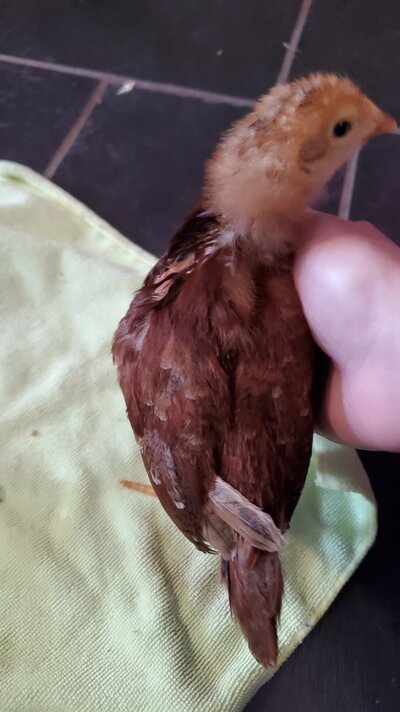2ndTink
Crossing the Road
- Aug 23, 2020
- 5,678
- 29,033
- 896
We have a 3 wk RIR pullet who wasn't showing any signs of illness or being off yesterday, but this morning was flopping / stumbling to the right until she'd get to the side of the brooder then she'd lean on that for support. Then she'd shake her head and jerk backward at times. She couldn't stand up on her own, her toes were all stretched out and she was rocking back on her hocks. She had crusty stuff on the left side of her neck and top of that left wing.
I used a wet paper towels to start to loosen the crusties, it wasn't blood, it was brown, really sticky, and smelled. To get it all off I ended up giving her a full body soak, the sticky stuff was all down her belly too. I got most of it off, when I was drying her I found a little glob of brown goo on her shoulder and used a wet q tip to get as much off as I could, I then applied antibiotic ointment. I couldn't find any red / irritated swollen spots, but it really seemed like a busted abscess or weeping from an infection which could have been under when I couldn't get cleaned of the brown goo. She's very alert, wants to eat, after I got her cleaned up and dried she drank a bunch of water and ate more. She can stand and walk on her own and she's stretching and preening again. She's still a bit unsteady, but bright eyed and holding her own.
I gave her a drop of Nutri-drench early this morning and dosed their water with Nutri-drench to try and help give her little body what it needs.
Does anyone know what could cause these symptoms? Could she just have gotten an abscess from feathers coming in and then all the sticky making her feathers clump together make her move like that? She's still not 100%, what should I watch for or what else should I be doing for her?
I used a wet paper towels to start to loosen the crusties, it wasn't blood, it was brown, really sticky, and smelled. To get it all off I ended up giving her a full body soak, the sticky stuff was all down her belly too. I got most of it off, when I was drying her I found a little glob of brown goo on her shoulder and used a wet q tip to get as much off as I could, I then applied antibiotic ointment. I couldn't find any red / irritated swollen spots, but it really seemed like a busted abscess or weeping from an infection which could have been under when I couldn't get cleaned of the brown goo. She's very alert, wants to eat, after I got her cleaned up and dried she drank a bunch of water and ate more. She can stand and walk on her own and she's stretching and preening again. She's still a bit unsteady, but bright eyed and holding her own.
I gave her a drop of Nutri-drench early this morning and dosed their water with Nutri-drench to try and help give her little body what it needs.
Does anyone know what could cause these symptoms? Could she just have gotten an abscess from feathers coming in and then all the sticky making her feathers clump together make her move like that? She's still not 100%, what should I watch for or what else should I be doing for her?



















